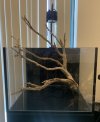Welcome to a new journey! A bit of rambling from a 20+ yr planted tank guy.
A Milwaukee PH controller is plenty to be honest. I used one for years for CO2 control in tandem with a DKH test and just repurposed it to control the CRx when I switched the tank to SW. The only real advantage i could see using an APEX is data logging of temp & PH along with automated water changes, leak detection, and redundant heater control.
The biggest deal with planted tanks is the huge variance in nutrient uptake between slow/fast growing species and being able to balance your dosing. Especially in light of the much faster growth in a CO2 dosed tank. One macro or micro nutrient depletes and you get more algae as plant growth stops/slows. The most common dosing regimen uses 50% weekly water changes to prevent buildup of all nutrients whilst preventing the depletion of any one nutrient.
Being able to "read" your tank visually is a huge deal. Seeing the signs of various nutrient defincincies in the plants leaves and stems lets you adjust your dosing to compensate. Shape, color, deformation, or death of leaves are all signs for different nutrient shortages. Learn the signs early and you'll be much more successful with a CO2 dosed tank. Auto dosing can be a time saver but if a nutrient depletes to the point of stalling growth you'll get hammered by algae growth. Other than ICP style testing there are some micro nutrients that just can't be tested for. The advent of an accurate, home based, real time testing solution for all the macro & micro nutrients for both FW and SW would be the single biggest game changer of the hobby bar none IMO.
Macro nutrients | Micro Nutrients |
| Used in large quantities by plants: Nitrogen, Phosphorous, Potassium, Calcium & Magnesium, Sulfur | Used in very small quantities by plants: Iron, Chlorine, Boron, Manganese, Zinc, Copper and Molybdenum. |
Honestly, I recommend hand dosing every few days along with visually checking plant growth for deficiencies vs auto dosing. You can adjust your dosing on the fly with experience. It's a good habit as you'll need to be trimming certain plants often anyway.
SFBAAPS isn't what it used to be when i started with them 20 yrs ago but still a good resource for knowledge and plants from swaps. The Planted Tank forum is much more active but of course not really local. The Barr Report forum is great from a science/tech standpoint for is low activity these days.
Aquaforest in SF or Aqualab in SJ both have a better selection of tissue culture plants than Neptunes. Hardscape selection is better too. Neptunes will often have FW fish not available other than online.
PS If you want glass inflow/outflow pipes, have spares.
PPS Siamese Algae eaters are cool fish, with a mean doppleganger that looks almost identical. They eat algae when young then get fat and lazy and stop.
PPPS Amano shrimp are great but will be mean and kill other shrimp like Neocardinia
PPPPS American Flagfish are hard to find but one of the best algae eaters out there. Mollies are great algae eaters too, they'll just breed you out of house and home

